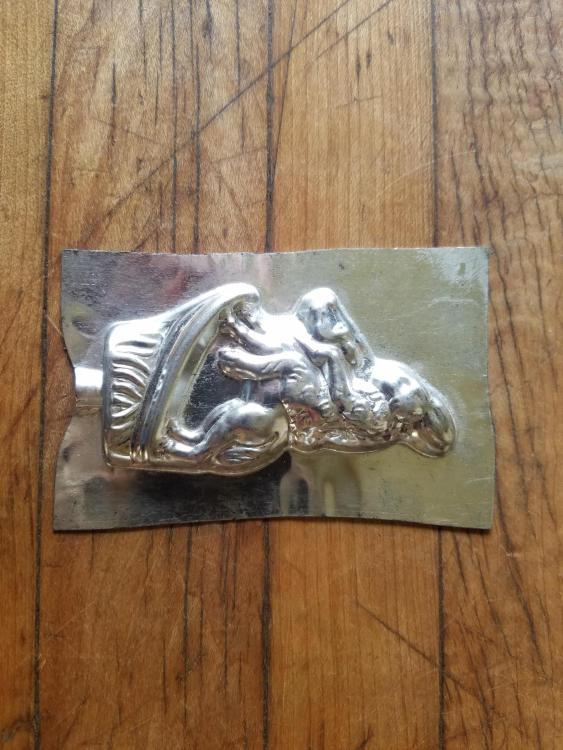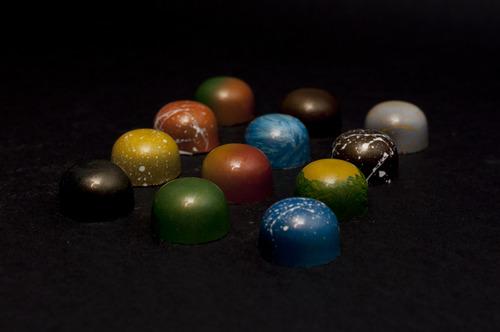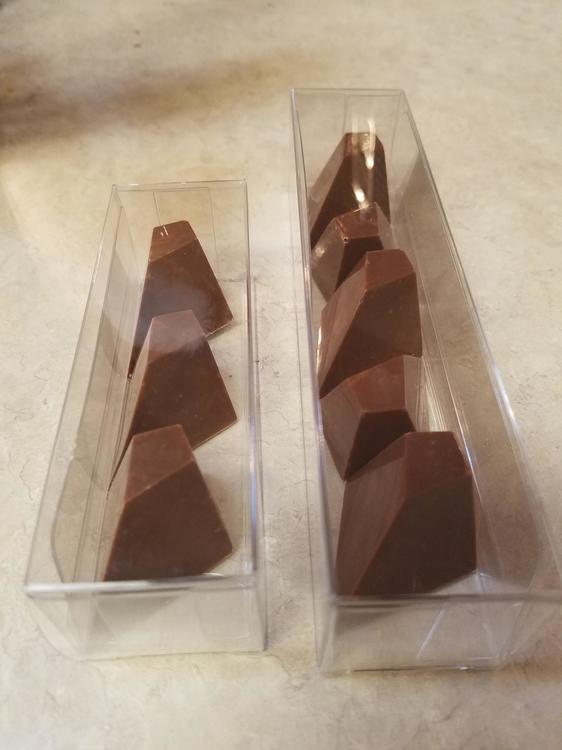Search the Community
Showing results for tags 'Chocolate'.
-
This cake, from the bakery inside Gelson's is my all-time favorite cake. They call it a Parisienne. I call it Chocolate Whipped Cream cake. I grew up eating it only on special occasions but as of late-since I don't live there- I get one every visit. And actually, sadly, over the years the quality and deliciousness has declined. Basically, it's a yellow layer cake, or maybe a spongy cake. (Either way, very light cake.) With sweetened chocolate whipped cream "frosting" decorated with chocolate shavings.... I am no where near Los Angeles, 8 months pregnant, and nothing satisfies my craving for this cake. So I decided to try to make it myself. Can't be so difficult, right? Simple Yellow cake? Whipped cream with chocolate in it? Chocolate shavings? My question is this: Do I need to add gelatin to the whipped cream to stiffen it? So that it "frosts?" If so, how much? Their cake needs to be refridgerated, but it holds it's shape for quite some time outside the fridge... Any input will be greatly appreciated by me and my unborn son....
-
I have a box of truffles that are good, but not great - my homemade ones are much better. So, I want to make something out of them. I don't want to use them to stick inside molten chocolate cakes or chocolate cupcakes, so I was wondering what would happen if I remelted them over a double boiler. I checked online, and couldn't find any information. Would they be totally ruined if I remelted them to make a sauce? If they can be remelted, should I add a little cream and/or butter?
-
My wife was jonesing, last night, for a better chocolate sauce than I usually concoct, and found one that sounded good on Cooks.com. The actual results were disappointing, and we'd like to understand what might've gone awry. The problem is that, while it tasted great in the pot, it hardened into an unpleasantly chewy, sticky, non-saucy solid when it hit the ice cream it was intended for. My wide thinks she may have added too much flour (she eyeballed it). I suggested that the butter may be the problem. Confectionery isn't either of our either of our strong suits, so we're hoping someone can offer some insights as to what the various ingredients and processes in this recipe might be intended to do. ----------------------------------------------------------------------------------------------------- HOT FUDGE SAUCE 2 c. white sugar 1 c. brown sugar 1 c. cocoa (Hershey's) 4 tbsp. flour 1/4 c. butter 1 1/2 c. water 1/2 tsp. salt 1/2 tsp. vanilla (added later) In a saucepan - mix dry ingredients. Add butter and water. Bring to a boil, and continue boiling for 10 minutes, or slightly longer. Remove from heat and add vanilla. Serve over ice cream.
-
I am looking for a recipe for a fantastic chocolate sauce (maybe with some bourbon or other yummy secondary flavor). Does anyone have a recipe they love and would pass along? I am thinking of a sauce that would be thick and rich and be stored in a jar and warmed up to pour over ice cream, etc.... Thanks!
-
I recently came back from france where I had the most delicious chocolate sauce on top of my profiteroles. I wanted to try to duplicate it here at home. Basically, the sauce was rich and velvety with a deep chocolate taste. It also didn't clump when placed on top of ice cream. (this sauce could be used for a coupe denmark or creme legiere). I have quite a few cookbooks at home (wybauw, torres, bo frieburg, chris felder, etc) but with all the different sauces and combinations for sauce in each of these books I was looking for opinions on where you found the best recipe or what you consider to be the best combination of ingredients for making a good sauce. I have very high end chocolate at home (becolade, felchlin with percentages of 65% to 72%). Jeff
-
At least in Europe comercial chocolate tablets are getting thinner. Usually 6mm thick and of course bigger in area. But I don't manage to find that kind of molds at manufacturer's sites (80 or 100g). Or at least choice is very limited. Why? Maybe too thin for manual unmolding? Or they just use bigger molds and fill partially? Thanks!
-
Several of Greweling's recipes call for the use of a round piping tip. I'm not familiar with what sizing system he's using. When he says to use a "no. [integer] round tip", what does the [integer] correspond to in millimeters or inches? For example, what is the diameter of a no. 3 round tip used by Greweling?
-
So I own a Chocolate shop, still new, there's a long way to go and many more years of learning. I'm going into more rounds of trying to hire staff and dealing with job postings and position titles etc. My question is. What are some of the best position titles you've come across (and worst). Or if you've ever experienced having to hire, what was your process for determining a position title. I want something that sort of encompasses the position and intrigues a candidate enough to look into the job description, but isn't either non representative of the scope of the job, or is just to fluffy and lame. For me a Chocolatier's Assistant, baker, supervisor etc are easy to use and understand. My problem is the front of house, retail staff side. I sell chocolate, but I also have an espresso machine and serve drinks. I expect someone to serve customers, but when no one is in, I need them to do the other odd jobs around the shop, like packaging chocolate and cleaning up. That being said, sure I could call them a Chocolate Shop Team member.... but when looking at each position as a whole, how will I determine internally which "Chocolate Shop Team Member" I'm talking about. That being said, if I post something like barista, there is a certain expectation of what a barista is. I'm thinking a candidate will make assumptions about it, like that it's short term, paid minimally, and they can just come and go as they like. Anybody have any thoughts on this, or am I just overthinking it way too much.
-
I'm continuing to play around with my ideas for a line of candy bars. My first two have been huge successes. For the third idea I have, I'd be looking at solid chocolate with hazelnut and toffee inclusions. I don't have any bar molds, but will be looking into getting some. When molding chocolate with inclusions are there any tricks I should be aware of to get a nice finish on the chocolate?
-
As a newbie here I thought, before piling in with my own questions, I'd pull together some of the things I've learned in my first months of chocolate making - in case this helps others who embark on the same path. Many of these learnings came from eGullet, some from elsewhere, and I'm very grateful for all the many sources of experience and insight. Cooking technique is quite personal so of course not everyone will agree with my idiosyncratic list of course. Most useful equipment so far Cooking isn't really about the equipment - you can make fine chocolates with hardly any equipment - but here are the things which have helped me the most. 1. Small tempering machine. This got me started on chocolate making with a superb easy path. The ChocoVision Rev 2B (with the "holey baffle" which increases its capacity) just gets the tempering perfect every time. Yes, I could temper in the microwave or on a slab, but it's great to take away any uncertainty about the final finish, by using this great machine. Downsides: continuously noisy, doesn't have the capacity for large batches. 2. Plenty of silicon baking mats (Silpat clones). I use these not just for ganache and inverting moulds onto, but also just to keep the kitchen clean! Working at home, I create a lot of mess and found I could reduce the risk of divorce by spreading large sheets (60x40cm size) across the work surface. So much easier to clean, and I can scrape unused chocolate back into the supply for next time. I get mine directly from China through AliExpress where they are about 1/3 of the local price. Then, for a further cost saving I ordered a couple of sheets of stainless steel at exactly the same 40x30 size, from a hobbyist place, and stuck some rubber feet underneath. The silicon mat + steel sheet can then easily be carried to the cool room. I got metal bars made up by another hobbyist place (an eGullet suggestion) which was a cheap alternative to caramel bars. 3. Scrapers. Life got better when I stopped trying to scrape moulds with a regular palette knife. I found we had two Japanese okomoniyaki spatulas from Japanese cooking which were perfect! 4. Polycarbonate moulds. Again in order to afford a bunch of these, I get them from China via AliExpress where they are £5-£7 each (including shipping) rather than £18 (+£10 shipping) locally. If I were starting again I'd buy little squares and half-spheres first, because these are easy to decorate with transfer sheets and cocoa butter respectively; plus a bar mould for quickly using up some extra chocolate or making a snack for the family. Magnetic moulds are not in my view essential for the beginner because you can just apply the transfers manually - but they are very easy to use. 5. Hot air gun - little Bosch paint stripper from Amazon. Always kept to hand to sort out anything which crystallises too quickly in the bowl or on my equipment. 6. Fancy packaging. We got some little boxes in bright colours with silver lining - great to turn your experiments into gifts. Quite expensive because you have to buy quantities, but worth it we felt. If I were working at scale I think my top 5 would also include a vibrating table, but that's beyond my means. Best sources of learning so far (apart from eGullet of course) 1. Callebaut website - fabulous range of videos showing how a master does the basic techniques. Also Keylink (harder to find on their website - look in "knowledge bank") which is refreshingly straightforward. 2. Several books recommended on this forum. Once I got past the basics, I delved into two masterpieces: Wybauw ("The Ultimate Fine Chocolates", a revised compilation of his previous books) and Greweling ("Chocolates and Confections"). These are just awe inspiring. Most useful ingredients so far 1. Callebaut couverture "callets" in 2.5kg bags - quick to measure, easy to re-seal. Everyone should start with 811 and 823, the "standards" ... but I soon moved to more exotic flavours. Current favourites are Cacao Barry Alunga (rich milk), Callebaut Velvet (white but not as cloying as the usual one; lovely mouthfeel), and half a dozen Cocoa Barry dark chocolates which go with particular ingredients. 2. Boiron frozen fruit purees. These are just amazing. I struggled with lots of different approaches to fruit flavouring until I discovered these. The problem is that most liquid purees have a short life span and are quite expensive if you only need a little quantity - whereas the Boiron ones just live in a neat, stackable tub in the freezer. Grab a flavour, pop it out onto a chopping board, slice off what you need, return the rest to the freezer. And the range is fabulous. So far I've particularly enjoyed raspberry, passion fruit, kalamansi (wow!) blackcurrant, and Morello cherry. (I'm experimenting with banana but most banana chocolate recipes seem to need caramel which I don't find so easy to perfect.) 3. IBC "Power Flowers" so I can mix my own coloured white chocolate with a wide palette of colours, for brushing or piping into moulds as decoration. Quite tricky to scale down to the tiny amounts I need, but I found this far better than heating little bottles of cocoa butter and being restricted to the colours I had. 4. Marc de Champagne 60% - great for truffles. My supplier sends it in a little chemical bottle which is a little un-champagne-like, but never mind. Rose drops (oil-based) were also useful for truffles if you like that sort of thing. Suggestions for learners (aka things I wish I had got right) 1. Start learning in winter. There is a HUGE amount of cooling needed in chocolate making; once we had cold weather we could close off a room, turn off its heating, and create a cool room. Made a big difference to productivity (and quality!). 2. Don't do anything involving caramel, marshmallows, turkish delight, or other temperature-critical sugar work until you are confident with everything else - or you will get demoralised quickly. Or maybe I'm just rubbish at these techniques. 3. Learn simple decoration (cocoa butter colour, texture sheets etc) early on. These make a big difference to how everyone will react to your work. 4. Don't rush. Chocolate making takes a lot of (elapsed) time. Give things time to crystallise properly. I find there is always an endless amount of cleaning-up to do while I wait :-)
-
I make shell molded truffles. After my neck fusion, shaking out chocolate from the molds is difficult at best. I went to a local chocolate shop and they have a Savage Brothers temperer with a vibrating machine built in over the bowl. They flip the mold over, turn the vibrator on, and dump the chocolate that way and it looks wonderful. They also double wall these truffles. That machine is $50,000 I'm told. I need a bigger tempering machine than what I have as well. I currently use a Revolation Delta and I love it. I'd get the 3Z but it doesn't have a vibrating machine build in. I prefer to buy used. I need suggestions that are in the $5000-$8000 range if they even exist. I'm self taught so any advice would be helpful.
-
I purchased this mold recently on eBay, and have been having a spirited discussion about it with the vendor. I am curious about the irregular edges on the piece, which look to me like the result of the application of a pair of metal snips to a larger mold. Does anyone recognize this mold, and can comment on whether or not this is, in fact, the way the mold would have looked when originally fabricated? Thank you in advance for any information you might be able to provide.
-
Hi to All, I have been reading the chocolate/confectionary related posts for a while now and have finally gotten around to upgrading so I can start asking some questions! Something I have been wondering is what makes the liquid centers in moulded chocolates? (eg., a lemon myrtle or violet cream where you bite into it and a "syruppy" centre runs out). Is it something I can make at home? Is it a fondant that has something added to make it form the liquid? Any help appreciated
-
I just got back from montreal and stopped by suite 88 a chocolate shop on St. Denis St. They had some really interesting chocolates which were delicious. One category was chocolates filled with different liquors /cocktail combinations. I didn't actually realize this until after I got them and she asked if I knew how to eat them. I said I think so and she then mentioned that I bit a portion and "drink" the liquor and then eat the shell or eat them in one bite. (I had thought they were ganaches). How would one get the liquor into the molded chocolate?
-
Hello everyone, The truth is that I have not written before in this forum but I do read it daily and I know that there are very experienced people in everything related to chocolate. It is for this reason that I wanted to ask for your help with the following: I'm trying to make liquor-filled bonbons, I've tried coating them with cocoa butter before closing, but almost all leak.If I make the closure only with chocolate, it's a disaster Can anyone share a method for doing this and stop pulling my hair? Thank you in advance.
-
Hello, I've been trying to make these liquid center pralines using starch and then covering with tempered chocolate for the las couple of days. I am having problems when I pour the syrup in the starch holes. I've managed to make it in a way that it doesn't penetrate the starch(sometimes), but when I have to cover the filled holes with more starch it just goes trough the liquid, it doesn't stay on top of it. Almost forgot, if anyone has thought in a way to put them in a painted mold (with the chocolate shell already of course) I would like to read your experiences before I start experimenting myself. Hope you could give me some advise. Greeting from Peru P.D.: I don't post much in the forum, but I do read it and appreciate a lot any help you can give me, much of the advise you gave me took me from failing with painting to this: (many thanks to Kerry and everyone that helped me)
-
Although Cacao Barry is the French Division of Callebaut, is there any noticeable difference in taste between the two cocoas? Has anyone compared them side by side?
-
What kind of boxes do people use to package non-standard molded bonbons? Specifically the longer ones like the cacao pod, teardrop or "slug". I bought molds that I love but they dont fit in the standard paper cups or trays and Im struggling to figure out how to package them. I'm just getting started with my chocolate business so I'm not at the point where I am ready to invest in custom packaging. I bought some boxes that I like from ClearBags and am planning to add a branded label but I dont think they're secure enough. My chocolates will shift all around if given the chance. Any advice would be great.
-
I know this question gets asked frequently, and I've done my research, but I can't believe that I can't find a less expensive option for packaging to hold 2 truffle-sized bonbons. The two options I liked (from Nashville Wraps and BoxandWrap) come to over $1.60 each when factoring in shipping. There is no way to price them at that cost. Am I missing some options out there?
-
Hi all! My daughter and I are headed to Belgium this summer, just for a few days, and would love to sample and visit some great spots. Right now we just have Chocolate World in Antwerp on our agenda. I'd love any suggestions on unique (or not unique!) chocolate or pastry experiences. Or places to avoid! Thank you! Jen
-
Is there some simple way to enrobe lemon curd in chocolate? Perhaps by freezing the curd first? Could it easily be wrapped in a ganache? Maybe injected into balls of ganache? Thanks!
-
I really like the combination of lemon and chocolate, so have been thinking about making a lemon curd (or lemon butter) filled chocolate ... but the concept seems to have a couple of potential issues. One of which is that the curd is quite soft - and I've had issues before when putting the bottoms on moulds with a soft filling, that the filling mixes into the botton - creating holes that leak. I was thinking of making the lemon curd firmer - but not quite sure how to achieve this ... could I mix it with chocolate to create a sort of ganache? (would mixing the lemon curd with chocolate = lump of disaster?! ) or would ie be better to up the egg component? Given lemon curd is usually refridgerated - would I also need to keep the chocolates refridgerated (and therefore have problems with moisture?). Would be interested in any comments or experiences?! Thanks!
-
I was going through ideas for bonbons and was thinking a bon bon using a lemon curd as a filling layer. I am curious if this would present shelf life issues. The curd would be baked until set then piped. Does anyone have any experience with this or water activity tests they've done?
-
Hello everyone, I am brand new to eGullet. I started playing around with chocolates about two years ago. Mostly basic truffles, and bark and similar things. I'm excited to learn a lot from everyone here as I can tell just by a quick glance over some of the discussions that there is a lot of great information passed on by great people. Today I have a question related to my first experiment in making molded chocolates about a year ago. At the time, I just wanted to see what molding was like, so I made the shells (which turned out suprisingly well), but hadn't really planned a filling. On a whim, I filled them with a tasty strawberry jam. They turned out quite nicely. Since them, I have also made various flavor curds (sugar, egg yolks, butter, and juice) which I have used. They seem to taste pretty good and go down well at parties. As I'm learning more about chocolate making, I've noticed that these kinds of fillings don't seem to be used by anyone. Is this purely a shelf life issue? All my chocolates have been eaten within a week (often much less) of making, and I've never noticed any issues. Have I just been lucky? The people I've fed them to seem to enjoy them, especially a double layer one I made for a cinco de mayo party that was lime curd and chile ganache. Any other ideas why jam and curd type filling aren't used? Katie
-
I have no difficulty tempering chocolate, but I do have a hard time keeping it at optimal dipping temperature for long periods of time. Can I buy a temperature-controlled melter, into which I can pour my tempered chocolate, for significantly less than I can buy a home tempering machine? If so, what model should I look for? Thanks, Jonathan














